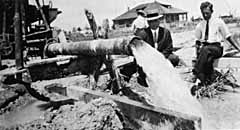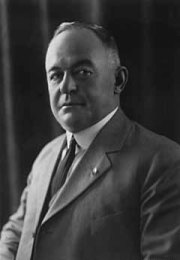
Pete Buol watches water flow like black gold out of an artesian well.
Las Vegas mayors seem to have always been a colorful group. Then as now, they were frequently outspoken and seemed to attract controversy. Though Las Vegas was founded in 1905 with the famed land auction it would be six years before the citizens of that small dusty community felt the need for a mayor. The city of Las Vegas was incorporated in 1911 and with that brought the need for a mayor.
The first mayor was also one of the biggest civic boosters. Along with "Big Jim" Cashman, Sr and Maxwell Kelch, Las Vegas city boosters tend to have larger than life personalities. Pete Buol was no exception. He was the optimistic sort who looked at that dusty railroad town and could see a brighter future ahead. Not everyone has that knack and Buol appears to have possessed it in spades. According to his campaign literature "ability doesn't count, knowledge is useless, experience has no worth without the driving force of optimism." He had grown up in Chicago, the son of a Swiss master chef. He had an eighth grade education but more importantly, he had ambition.

Pete Buol the first mayor of Las Vegas
He won a lottery at 19 and found himself worth over $100,000. Unfortunately for Buol, he didn't have the acumen for finances and quickly ran through the money. He made another small fortune with a food concession at the Chicago's Exposition. He served over 5,000 people a day, charging $.25 cents a meal.
He came west and spent some time in Hollywood before heading to Nevada. He had hoped to invest in a mine in Goldfield but, as he later told a reporter, his bankroll was too small in Goldfield to have much of an impact. He decided to go to Las Vegas. He arrived by stagecoach just ahead of the railroad and the land auction.
The town was barely a town. There was the old Kiel Ranch, the Stewart Ranch and a couple of wildcat businessmen, Jim Ladd and John Miller, had some tent hotels. The only physician in town, Halle Hewetson, operated out of a tent. Buol decided that real estate might be worth investing in.
In 1905, at the land auction, Buol had two subdivisions for sale. Buol's Addition, which was just west of the railyard, shops and Ice Plant and Buol's Sub-division was "just far enough away to be out of the noise and smoke of the shops and engines."
Buol quickly realized that one of the most important elements of selling real estate in this climate was water. The Railroad had secured the water rights to Big Springs, the large artesian springs, which fed the creek that ran down to the Stewart Ranch (where the Sawyer Government Building is today). But Buol noticed that there were other artesian springs bubbling up around the valley. Less than six months after the land auction, Buol was the manager of the Vegas Artesian Water Syndicate and he was ready to start drilling for water.
Buol was not the only one drilling for water. Others were drilling for irrigation and crops. Buol was drilling to enhance housing development. In 1910, he brought in a large well near 6th and Fremont (near where the El Cortez is today), adjacent to his Buck's Addition.
The railroad had long resisted supplying water to those outside the original township. But with Buol's water supply, the area east on Fremont and north (to where the freeway is today) was able to develop into a very residential area.
Buol and a friend ran for mayor because no one, according to Buol, was interested in the job. He won by 10 votes. His salary was $15 a month. One of his first orders of business was rules for business licenses. He served for two years, being succeeded by the man who had run against him, his friend Bill Hawkins. He was then elected to the assembly.
He and his wife built a home at Seventh and Ogden. According to writer A.D. Hopkins, their house had "walls eight inches thick, adobe inside and brick without, porches on all four sides, and a peaked roof, it was said to be the coolest in summer and warmest in winter of any in town. Its eight rooms were heated with wood fireplaces. " When Mrs. Buol entertained her lady friends, Buol would serve them gourmet dishes harking back to his gourmet days with his father.
Through his connections, Buol met a Scotsman, Sir John Murray. Murray had traveled extensively around the United States. The two men corresponded and Buol traveled overseas to pitch an idea for a new development to the wealthy Scot. Murray agreed to invest $100,000 in the new development ot be located on the far west side of the train tracks. Buol returned home a hero to the townsfolk who were worried about the continued growth of the town.
Unfortunately, World War I interfered with Buol's plans. Once Britian entered the Great War there was a ban on all exported assets. Buol had to abandon his idea of an agricultural oasis just outside of the little town he loved. However, the name stayed attached to the development and later become one of the most sought-out addresses for those who could afford it, the Scotch 80s.
Buol continued speculating. Some of his efforts are now long-forgotten such as the little town of Johnnie or Plantina (near where Sandy Valley is today). However, he invested in a lime deposit that helped establish the town of Sloan. He had a borax claim that was said to have netted him $250,000 when he sold it to Francis "Borax" Smith.
In 1925, Buol and his family left the little town that he had done so much to develop and moved to the California Coast. He continued to pursue his mining claims and was badly injured in a mine cave-in in 1929. He died ten years later following a stroke.
Though he made a great deal of money during his lifetime, he died relatively poor. But Pete Buol's legacy lives on in the town that he believed in so fervently, the Scotch 80s are still one of the most sought off addresses in VeryVintageVegas.
Special thanks to the Las Vegas Review Journal for letting us use these images.
If you are interested in a home in the Scotch 80s, we encourage you to contact the crew at VeryVintageVegas.com




